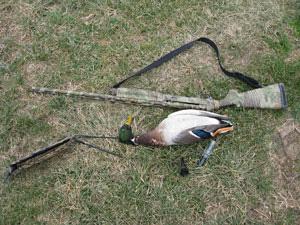Kentucky Afield Outdoors: Waterfowl hunting options that don’t crush the pocketbook
Published 12:00 am Monday, December 20, 2010

- Lexington waterfowl hunter James Charas with a drake mallard taken near a Midway, Kentucky farm pond in January. A few money saving techniques can put waterfowl hunting into the reach of many, even in these economic challenging times. Farm ponds, small rivers and creeks all offer good hunting with an expensive outlay for equipment.
A close friend used to always badger me about going waterfowl hunting. I hemmed and hawed because I didn’t have the right equipment, nor did I have the money to buy it. I mistakenly believed you needed an expensive shotgun, a ton of decoys, expensive bibs and parkas, waders, dogs, calls and, not to mention, a boat. I felt the sport involved an outlay of treasure beyond my reach.
With gentle prodding from my buddy, I began to slowly accumulate the necessary gear. I waited until after the season and found a nice 4-in-1 waterfowl jacket on closeout for half of what it cost earlier in the season. I also found a pair of waterfowl bibs on sale from the same manufacturer. The camouflage patterns don’t match, but ducks never seem to mind. I’ve hunted a pond in a pouring rain with temperatures in the high 30s and remained warm and dry. In my old inadequate patched together gear, those conditions would send me packing for the house in under an hour.
The new waterfowl hunting outfit also makes the best winter fishing gear I’ve ever donned. I’ve fished the float and fly technique for smallmouth in January with air temperatures in the low 20s with the wind chill in the teens and stayed warm all day long.
“The closeout waterfowl clothing may not match or is a little out of date, but if it keeps you warm and comfortable, that is all that matters,” said John Akers, maintenance supervisor for the Kentucky Department of Fish and Wildlife Resources. “You can save a lot of money by purchasing waterfowl gear after the season. It still works fine. They often discount hunting waders really low after the season.”
Akers, an avid and expert waterfowl hunter, recommends holding on to that gear a while if you have children. “I outfitted my kids with my old waterfowl apparel,” he said. “If my bibs or waders got a little worn, I saved them as I replaced them. About half of the stuff my kids use, I used to use myself. They’ll grow into it eventually.”
A reliable 12-gauge pump shotgun will harvest any waterfowl that flies in Kentucky. Decent used pumps with synthetic camouflage stocks that can handle 3-inch magnum shells line the walls of gun stores all over our state. An outlay of $200 or less will often bring that gun home.
A pump shotgun doesn’t have the glamour of an elegant over-and-under or the ease of use of a semi-automatic. That being said, every time you pull the trigger, a pump goes “boom.” Pumps handle adverse weather with ease and you can enjoy your waterfowl hunting without stressing over damaging an expensive gun in the snow, rain or ice. A pump shotgun handles rough treatment and still performs.
Waterfowl shotshells loaded with steel, bismuth, tungsten or other heavy materials cost considerably more than shotshells loaded with lead. “Many of the department stores and sporting good stores discount their steel shotshells after the season,” Akers said. “I buy all of my waterfowl loads after the season.”
It is illegal to use lead shotshells for waterfowl hunting.
Decoys can also deliver a wallop to your wallet. “In the old days, I would go in with a friend and split the cost of decoys because we couldn’t afford them on our own,” Akers explained. “We traded use of them. We also bought a boat that way as well. You can find decoys really cheap at yard sales as well.”
Hunters inadvertently shoot decoys, leading to many that are no longer seaworthy. Akers has an ingenious plan to keep decoys useable for many years, even after they’ve been shot.
“Buy a can of low expansion foam used to fill gaps around pipes,” Akers said. “Shoot the foam inside the decoy. A can will fill three or four decoys. They will never sink again, no matter how many times your buddies shoot them.”
John Brunjes, migratory bird biologist for Kentucky Fish and Wildlife, used another system to save money on decoys in the past. “You can buy a dozen of the low end water keel decoys for $25 or so,” he said. “They have a hole in the keel to allow water inside intended to keep them upright and in place. Water-keeled decoys flip over in the slightest wind. I fill the bottom cavity with sand and plug the hole. You can also use a bolt. Filling the bottom with sand helps keep them upright.”
You also don’t need to own a boat or dogs to successfully waterfowl hunt. Farm ponds, small rivers, creeks and even reservoirs offer bank waterfowl hunting opportunities. A set of neoprene chest hunting waders will help retrieve downed birds from shallow creeks, rivers and ponds. Poles designed to set and retrieve decoys also work well for recovering downed birds.
Finding a place to hunt is one of the biggest challenges of waterfowling. Most hunters can’t afford to pay a lease arrangement with a landowner. “I’ve traded labor rather than pay for a lease,” Akers said. “A farmer with a river system on his property caught my eye. I knocked on the door and said ‘I noticed your barn door is off its track.’ I offered to fix it in exchange for hunting rights. I can still hunt there to this day. We’re friends now. I’ve even changed faucets in exchange for hunting rights.”
With the economy in the dumpster, frayed nerves everywhere and money tight, use these simple tips to get into waterfowl hunting and save some serious money. A day in a homemade blind pursuing ducks is salve to jarred nerves and relieves the winter doldrums.
Author Lee McClellan is an award-winning associate editor for Kentucky Afield magazine, the official publication of the Kentucky Department of Fish and Wildlife Resources. He is a life-long hunter and angler, with a passion for smallmouth bass fishing.
The Kentucky Department of Fish and Wildlife Resources manages, regulates, enforces and promotes responsible use of all fish and wildlife species, their habitats, public wildlife areas and waterways for the benefit of those resources and for public enjoyment. Kentucky Fish and Wildlife is an agency of the Tourism, Arts and Heritage Cabinet. For more information on the department, visit our website at fw.ky.gov.






